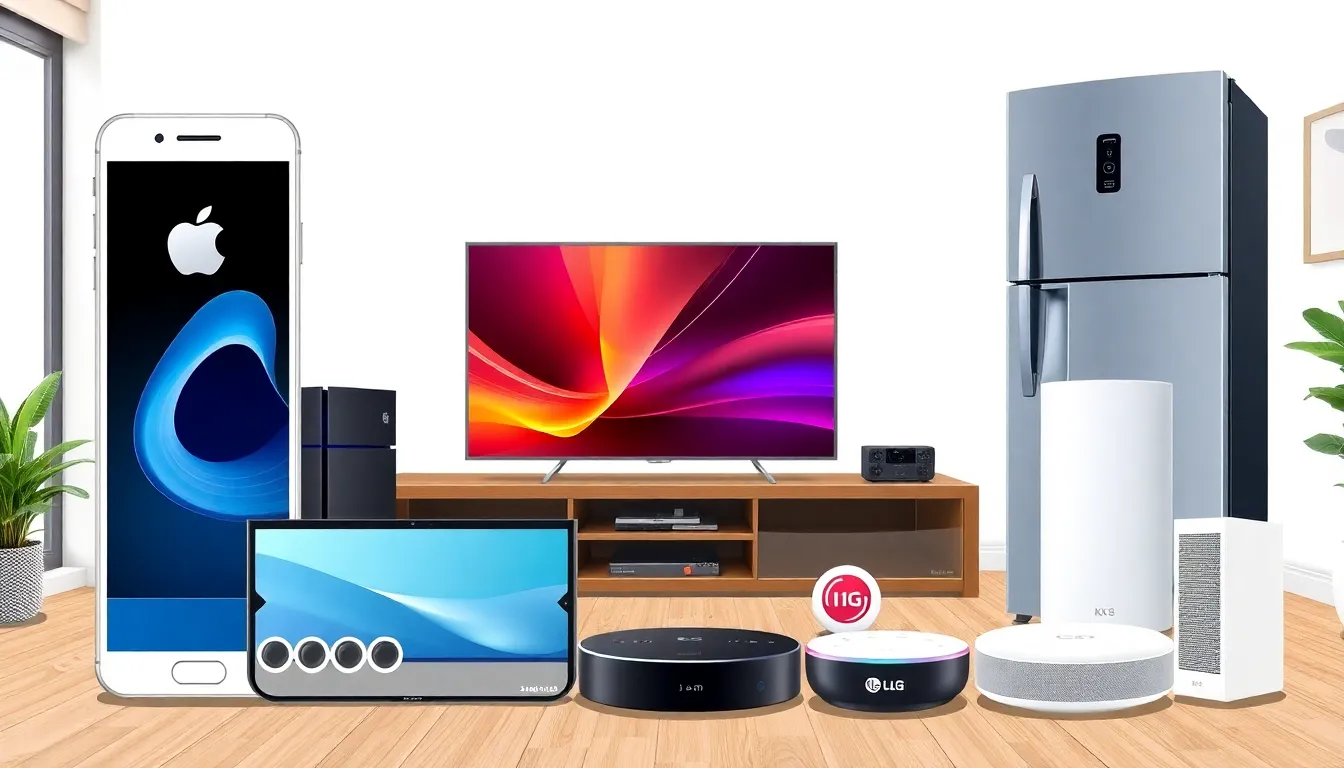Table of Contents
ToggleIn a world where gadgets seem to multiply faster than rabbits, consumer electronics companies are the wizards behind the curtain. They conjure up everything from sleek smartphones to smart fridges that can remind you when you’re out of milk. It’s a thrilling time to be a tech enthusiast, but with so many options, finding the right company can feel like searching for a needle in a haystack—if that haystack was also buzzing with Wi-Fi signals.
These companies don’t just sell products; they sell dreams of a smarter, more connected life. Whether it’s battling for the title of the best gaming console or the latest must-have wearable, the competition is fierce and the stakes are high. So, buckle up as we dive into the electrifying world of consumer electronics, where innovation meets everyday life, and every click could lead to your next favorite gadget.
Overview of Consumer Electronics Companies
Consumer electronics companies design and manufacture devices that enhance daily living through technology. Global leaders in this sector include Apple, Samsung, Sony, and LG, known for their innovation and quality. These companies produce a variety of products such as smartphones, tablets, laptops, TVs, and smart home devices.
Revenue generation in the consumer electronics industry exceeds $1 trillion annually, showcasing its vast economic impact. According to Statista, global revenue is projected to reach around $1.5 trillion by 2024. Continuous advancement drives competition among companies, pushing them to release cutting-edge products frequently.
Innovation fosters the development of new technologies like augmented reality, artificial intelligence, and smart sensors. These technologies are integrated into consumer electronics, creating more interactive user experiences. For instance, smart appliances not only simplify routine tasks but also offer energy-saving solutions.
Market leaders invest heavily in research and development to maintain a competitive edge. Apple’s commitment to design and functionality attracts a loyal customer base, while Samsung’s extensive product range appeals to various market segments. Companies focus on sustainability as well, emphasizing eco-friendly production processes and recyclable materials.
Emerging manufacturers, especially in Asia, contribute to the competitive landscape, offering alternative options and lower price points. As consumer demand shifts towards smart technology, legacy companies adapt their strategies to include internet-connected devices.
Consumer electronics companies play a vital role in everyday lives by delivering innovative products designed to simplify and enhance user experiences.
Major Players in the Industry

Several companies dominate the consumer electronics sector, characterized by their innovation and product diversity.
Top Global Brands
Apple stands out as a leader in smartphones and laptops, attracting a loyal customer base. Samsung excels in offering a wide array of products, from appliances to mobile devices. Sony, renowned for gaming consoles and audiovisual equipment, maintains a significant market presence. LG is recognized for its high-quality display technologies and home appliances. These brands collectively contribute to the industry revenues by leveraging advanced technologies. In 2022, combined sales from these companies reached over $400 billion, underlining their pivotal roles in the consumer electronics landscape.
Emerging Companies
Numerous emerging brands are disrupting the market with competitive pricing and innovative offerings. Xiaomi, for instance, focuses on smartphones and smart home devices, targeting budget-conscious consumers. Realme has gained traction by providing feature-rich smartphones at affordable prices. OnePlus appeals to tech enthusiasts with high-performance devices that challenge established players. These newcomers are rapidly capturing market share, prompting established companies to innovate. Industry projections indicate that these brands could collectively account for 30% of market growth by 2024, reflecting changing consumer preferences.
Trends Shaping Consumer Electronics
Consumer electronics continuously evolve, influenced by innovation and sustainability efforts. Companies adapt to changing consumer preferences, creating exciting products that enhance everyday experiences.
Innovation and Technology
New developments within consumer electronics drive the market forward. Augmented reality and artificial intelligence reshape user interactions, making technology more intuitive. Companies like Apple and Samsung lead the charge, investing billions in research and development. Cutting-edge features, such as enhanced camera systems and smart home integration, attract consumers seeking the latest advancements. Emerging brands also introduce innovative solutions, challenging established giants. Competitive pricing strategies from companies like Xiaomi and OnePlus encourage rapid adoption of new technologies, fueling industry growth.
Sustainability Efforts
Sustainability becomes a priority for consumer electronics companies. Corporations are increasingly focusing on eco-friendly materials and circular economy practices to reduce their environmental impact. Major players like LG and Sony commit to sustainable sourcing and energy-efficient products. Eco-conscious consumers drive this trend, demanding transparency and responsibility. Many companies implement recycling programs, encouraging responsible disposal of electronic waste. Achieving comprehensive sustainability goals positions companies to retain customer loyalty while meeting regulatory expectations. Enterprises that embrace sustainability not only enhance their brand image but also contribute to a healthier planet.
Market Challenges for Consumer Electronics Companies
Consumer electronics companies face several significant market challenges. These issues impact their ability to innovate and capture market share effectively.
Supply Chain Issues
Supply chain disruptions pose a major challenge. Companies encounter delays in component sourcing and manufacturing, affecting product availability. Rising shipping costs and limited container availability contribute to this dilemma. Semiconductor shortages specifically hinder production, leading to delays in product launches. Industry leaders invested heavily in technology to manage these disruptions, but uncertainty remains a concern. Strategic partnerships, regional sourcing, and inventory optimization become essential for mitigating these issues.
Competition Dynamics
Intense competition drives rapid innovation in the consumer electronics market. Major companies continually invest in research and development to maintain their edge. Emerging brands offer affordable alternatives, increasing pressure on established leaders. Traditional brands like Apple and Samsung face threats from disruptors like Xiaomi and Realme. Price competitiveness and unique features influence consumer choices significantly. Keeping up with evolving consumer preferences requires agility and a keen understanding of market trends. Companies that adapt quickly to the shifting landscape will maintain relevance and customer loyalty.
Future Outlook for the Industry
Technological advancements are reshaping consumer electronics, as companies continue to innovate. By 2024, the industry is projected to reach approximately $1.5 trillion in revenue, driven by demand for smart devices and integrated solutions. Competition remains fierce, with established players and emerging brands investing significantly in research and development to create high-quality products.
Sustainability emerges as a cornerstone of future strategies, with companies prioritizing eco-friendly materials and practices. Major brands like LG and Sony focus on energy-efficient products to align with the increasing consumer demand for sustainability. Investment in sustainable sourcing is seen not only as a regulatory requirement but also as a method to enhance brand loyalty.
The rise of artificial intelligence and augmented reality technologies stands out, as organizations aim to make everyday experiences more intuitive. Emerging manufacturers, especially from Asia, are gaining traction, capturing an estimated 30% of market growth by 2024 through competitive pricing and innovative solutions. Established companies face challenges but remain committed to maintaining their market share.
Supply chain resilience becomes crucial as organizations encounter continued disruptions. Companies adopt technology and form partnerships to streamline operations and improve access to components. Keeping pace with rapid innovation, industry leaders must adapt to changing consumer preferences, pushing the boundaries of what’s possible in smart devices, wearables, and smart home technology.
Overall, the future of consumer electronics holds immense potential for growth and evolution. As organizations explore new horizons, the industry will likely witness extraordinary changes that redefine how consumers interact with technology in their daily lives.
The consumer electronics industry is on an exciting trajectory marked by innovation and sustainability. Major players are not just competing for market share but are also adapting to changing consumer preferences and technological advancements. As they invest in eco-friendly practices and cutting-edge technologies, the landscape is evolving rapidly.
Emerging companies are reshaping the market dynamics with competitive pricing and innovative solutions. This shift highlights the importance of resilience and adaptability in an industry characterized by constant change. With projections indicating substantial revenue growth, the future promises to redefine how consumers interact with technology, enhancing their everyday experiences.





